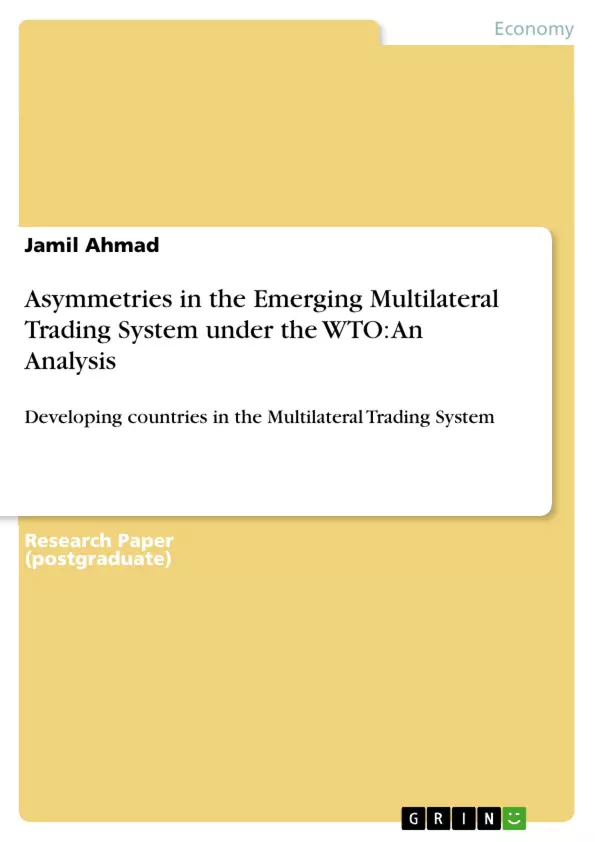The fundamental principles of the multilateral trading system is to help trade flow as freely as possible, on the one hand, and deal with disputes over trade issues on the other. The expansion of trade has played a dynamic role in the growth of the global economy since World War II. Trade is important for the development of all types of economies. But its sustained growth calls for a free and fair Multilateral trading system. A trading system that is rule based helps in the expansion of trade. Similarly, a trading system that lowers trade barriers through negotiations and applies the principle of non-discrimination promotes trade from developing countries. Further, the trading system that allows disputes to be settled effectively and constructively has the added advantage for the developing countries. The world trading system under the WTO promises all but its working over the past years since its establishment has revealed that the pace and pattern of implementation by different member countries have not been uniform. More powerful players in the trade space have evolved many new instruments of safeguarding their national interest while the weaker players have been forced to implement their commitments. This has generated asymmetries in the pattern of effective market access in the different countries of the world economy.
In the light of the above, our objective in this study is primarily to examine the role of Multilateral trading system under the WTO in promoting international trade of developing countries in general and that of India in particular. The purpose of this paper is (a) to discuss the importance of trade and trading system for developing countries in general and India in particular (b) to discuss the asymmetries exist under the WTO which effect the development process of developing countries adversely, and (c) to suggest ways and means as to how India and other developing countries can maximize the gain and minimize the losses from its membership of the world trade organization under the globalize era.
Keywords: Trading System, WTO, Developing Countries, Indian Economy.
Inhaltsverzeichnis (Table of Contents)
- 1.1 INTRODUCTION:
- 1.2 DATABASE AND METHODOLOGY:
- 1.3 IMPORTANCE OF TRADE AND TRADING SYSTEM FOR DEVLEOPING COUNTRIES:
- 1.4 ASYMMETRIES IN THE WTO
- 1.5 TRADE PERFORMANCE IN THE POST-WTO ERA
- 1.6 DEVELOPMENT AGENDA FOR DEVELOPING COUNTRIES
- 1.7 CONCLUSION
Zielsetzung und Themenschwerpunkte (Objectives and Key Themes)
This study aims to analyze the effectiveness of the multilateral trading system under the World Trade Organization (WTO) in promoting international trade for developing countries, specifically India. It examines the role of trade and trading systems in economic development, explores the asymmetries within the WTO that negatively impact developing countries, and proposes strategies to maximize gains and minimize losses for developing countries within the globalized trade environment.
- Importance of trade and trading systems for developing countries
- Asymmetries in the WTO and their impact on developing countries
- Trade performance of developing countries in the post-WTO era
- Development agenda for developing countries in the globalized era
- Strategies to maximize gains and minimize losses within the WTO framework
Zusammenfassung der Kapitel (Chapter Summaries)
The first chapter introduces the fundamental principles of the multilateral trading system, highlighting its importance in facilitating trade and resolving trade disputes. It emphasizes the rule-based nature of the system, focusing on the importance of negotiations, transparency, and non-discrimination. The chapter also discusses the significant reforms undertaken since the establishment of GATT in 1947, emphasizing the inclusion of new areas like agriculture, textiles, intellectual property rights, and services under WTO provisions. The chapter concludes by outlining the study's objective to examine the responsiveness of the multilateral trading system to the development needs of developing countries, particularly India.
The second chapter delves into the methodology and data sources employed in the study. The focus is on the post-WTO period, with comparisons to the pre-WTO era. The study utilizes secondary data sources, acknowledging their origin and providing a detailed description of the data used. The methodology emphasizes simple and analytical approaches.
The third chapter explores the significance of trade for developing countries, outlining four key reasons. First, it argues that trade is crucial for realizing the benefits of globalization, enabling access to new markets and technologies. Second, the chapter highlights the opportunities for developing countries to expand trade in goods and services due to the relocation of manufacturing activities. Third, the role of international production networks in breaking up production processes and fostering trade among regions and countries is examined. Fourth, the importance of international institutions like the WTO in creating a conducive environment for multilateral exchange of goods and services is emphasized.
Schlüsselwörter (Keywords)
This study centers on the analysis of the multilateral trading system, particularly focusing on the World Trade Organization (WTO) and its impact on developing countries. The key concepts explored include trade, trading systems, developing countries, economic development, asymmetries in the WTO, trade performance, development agenda, and strategies for maximizing gains and minimizing losses within the globalized trade environment. The study also delves into the significance of globalization, international production networks, and the role of international institutions in shaping the global trade landscape.
- Quote paper
- Dr. Jamil Ahmad (Author), 2011, Asymmetries in the Emerging Multilateral Trading System under the WTO: An Analysis, Munich, GRIN Verlag, https://www.grin.com/document/178492



